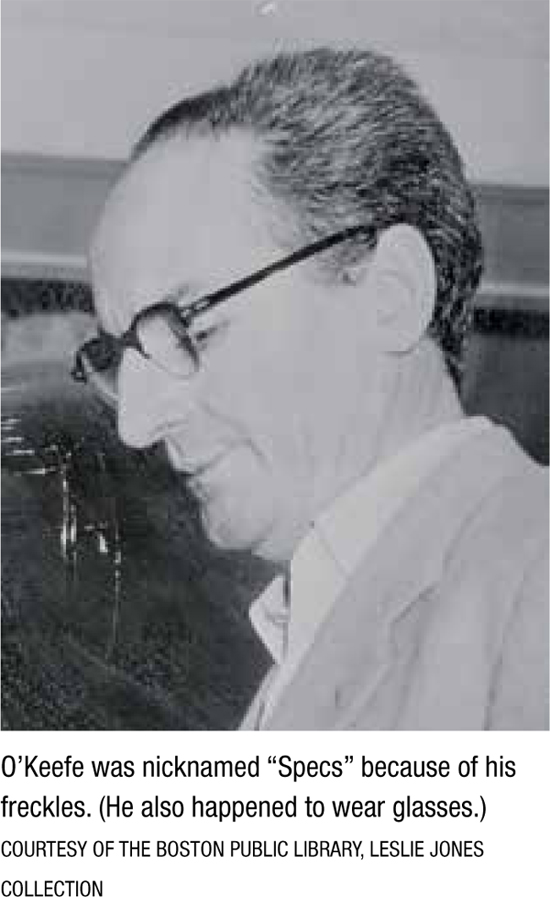
CHAPTER TWENTY-THREE
The three-story parking garage at 600 Commercial Street in the North End doesn’t look like much, but it’s actually listed on the National Register of Historic Places because it’s one of the oldest parking garages around. It’s also the site of one of the most infamous heists in history.
Originally built in 1925 for the North Terminal Corporation, the garage is bounded by Commercial Street, Hull Street, Prince Street, and the DeFilippo Playground. What makes this parking facility so unusual is that it was built into the steep slope of Copp’s Hill, which allowed cars to access the different parking levels directly from entrances on the street, so interior ramps weren’t necessary. When it first opened, it could accommodate seven hundred cars and was one of the largest indoor parking facilities in Boston.
The Brinks armored car and delivery service began operating out of the building around 1948, occupying space at the rear of the second floor. The company had a vault there, and rooms where employees could count and sort money.
On the evening of January 17, 1950, just before 7:30 p.m., a group of robbers wearing navy peacoats, gloves, chauffeur caps, and Halloween masks used an entrance at 165 Prince Street to sneak into the garage. Once inside, they forced the five Brinks employees to lie down on the floor, face down. They tied their hands together with rope and put adhesive tape over their mouths, and then they took off with $1.2 million in cash and $1.5 million in checks, money orders, and securities. Newspapers called it the “biggest robbery ever” and the “crime of the century.”
Early the next morning, police showed up on the doorstep of Sammy Linden-baum. He was on parole and living in a triple-decker at 26 Arlington Avenue in Revere and had been out of prison for less than a month—he did not want to go back. The police took him into custody as a suspect in the Brinks heist, and when they questioned him about the robbery, he insisted he was innocent. Luckily for him, he had a solid alibi and produced witnesses who could attest to his whereabouts at the time of the crime. Police had no choice but to let him go.
As the investigation continued, the following suspect list was developed: Anthony Pino, Joseph “Specs” O’Keefe, Adolph “Jazz” Maffie, Joe McGinnis, Vincent Costa, Henry Baker, Michael Geagan, Thomas F. “Sandy” Richardson, and James I. Faherty.
Anthony Pino, an Italian immigrant, and Joseph “Specs” O’Keefe, born in Boston to a large Irish family, were best friends from childhood. When O’Keefe was young, his family moved to South Boston, near Andrew Square, and he attended the John A. Andrew School at the corner of Dorchester and Rogers Streets. He started getting into trouble at a young age and was reported as saying, “We’d steal anything we could.” When he was twelve, he was sent away to the Lyman School for Boys, a reform school in the rural town of Westborough, but it didn’t help; he dropped out of school in eighth grade and followed his calling on the streets.

The Lyman School for Boys was a state reform school located about 35 miles west of Boston. Its 1,000-acre campus was located on Powder Hill in Westborough. In addition to Joseph “Specs” O’Keefe, notable alumni included Albert DeSalvo, aka “the Boston Strangler,” and Joe “The Animal” Barboza, who called Lyman a “hellhole” where boys were beaten with belts and pick handles. Specs O’Keefe was in and out of Lyman several times. One Lyman official wrote on the future Brinks robber’s school record: “The boy has had too much his own way. He has had the run of the streets.”
O’Keefe felt he was being cheated out of his share of the stolen money, and started shaking down the other members of the gang. At one point, in May 1954, O’Keefe and one of his cohorts kidnapped one of the robbers and held him for ransom. Soon after that, a hitman was hired to take out O’Keefe, and on June 5, 1954, it appears he found his target. O’Keefe was shot in Dorchester, but he survived. A few days later, on June 16, 1954, O’Keefe was targeted in Dorchester again, this time on Victory Road, near the intersection of Train Street. The gunman was Elmer “Trigger” Burke, a notorious gangster from New York who was described as a “kill-crazy psychopathic” by New York police. Burke chased O’Keefe through the neighborhood with a machine gun, firing more than thirty shots. Bullets struck the building at 21 Train Street. Police found a trail of blood that went on for nearly half a mile, down Train Street, across Adams Street and Centre Street, and onto Althea Street. O’Keefe was struck in his wrist and chest, but (amazingly) survived (again).
Soon afterward Burke was arrested by a Boston police officer in the vicinity of Huntington and Massachusetts Avenues. He’d had been staying in a rooming house nearby at 158 St. Botolph Street.
Patrolman Frank Crawford recognized him immediately.
“What’s your name?” Crawford asked.
“Elmer Burke.”
“Oh my God,” said Crawford.
Burke didn’t put up a fight. And back at the police station, Burke admitted to Carlson that he’d shot at O’Keefe.
“You made a better pinch than you think, Copper,” quipped Burke.
“I know,” said Crawford. “You’re wanted for murder.”
“Put an S on that, Copper,” said Burke. “It’s murders, not murder.”
Burke was arrested and placed in the Charles Street Jail. On August 28, 1954, at 2:40 p.m., he was among the 120 inmates who were getting some fresh air in the exercise yard. An unarmed guard named James Mead was in the guards’ TV room when he noticed Burke suddenly start running toward a large steel door that led to the solitary confinement cell block.
Mead tried to go after him, but when he reached the door he was met by an armed man wearing a black stocking mask and a uniform similar to what the prison guards wore. The gunman put a revolver between Mead’s eyes and said, “Back up, or I’ll blow your brains out.” Mead stopped his chase right there. He and the other guards knew there were three more locked doors standing between Burke and his freedom, and they figured he was hiding somewhere in the solitary confinement building. They alerted police about the attempted escape, and when they finally opened the steel door, they were shocked to find that Burke had managed to open the other three doors. He then apparently took off in a black sedan that was waiting for him at the curb on Charles Street.
■ ■ ■
Local hoodlum Joe Sylvester Banfield was well-known for his driving skills, and police suspected he had been behind the wheel of the getaway car the night of the Brinks robbery. Though his involvement was never proven, rumors abounded after his death on January 28, 1955, five years after the robbery.
Banfield was known to be a big drinker. In fact, when he was accused of robbing Brinks, he told police he could not have been involved because he got drunk on New Year Year’s Eve and had continued on a monthlong bender. However, one of his ex-girlfriends told authorities she saw him on the night of the robbery, and he didn’t appear to be drunk at all, so suspicions remained.
After the robbery, Banfield spent some time at Dr. John “Dropkick” Murphy’s alcohol rehab facility in Acton, Massachusetts, and there are rumors he hid his share of the loot there. He needed to get away from booze, and it was a nice place to get away. But he always seemed worried. Perhaps he was afraid the law would catch up with him, or perhaps he feared there were people out to get him and steal his cash.
Banfield’s stash was never reported to be found, and considering that he’d only had a few years to spend his share of the Brink’s cash before he died, maybe there’s some left, somewhere.
■ ■ ■
In 1955, Joseph J. “Specs” O’Keefe was in prison in the Hampden County Jail in Springfield, Massachusetts. One day a man by the name of Edward “Wimpy” Bennett came to see him.
“How are you, Joe? How’s tricks?”
“Why are you here?” O’Keefe asked him. “And who sent you?”
Bennett said the Brinks gang would give $5,000 to his wife and would take care of him later.
O’Keefe dismissed the offer, saying, “Look, you go back and tell them they’re not dictating to me any longer. I’m dictating to them. Tell them they’ve got to come up with my money, all of it, not a goddamn pittance. Tell them that if I don’t get my end they’re all going to be in trouble.”
Bennett left and came back the next week.
“Joe, it don’t look like you’re going to get any money. They’re not too much interested. They don’t fear anything is going to happen.”
When O’Keefe started to get angry, Bennett continued. “Joe, please don’t ever say I told you so, but they’re going to have you bugged. They’re lining up the doctors, the brains kind, to have you committed. Please don’t say I told you.”
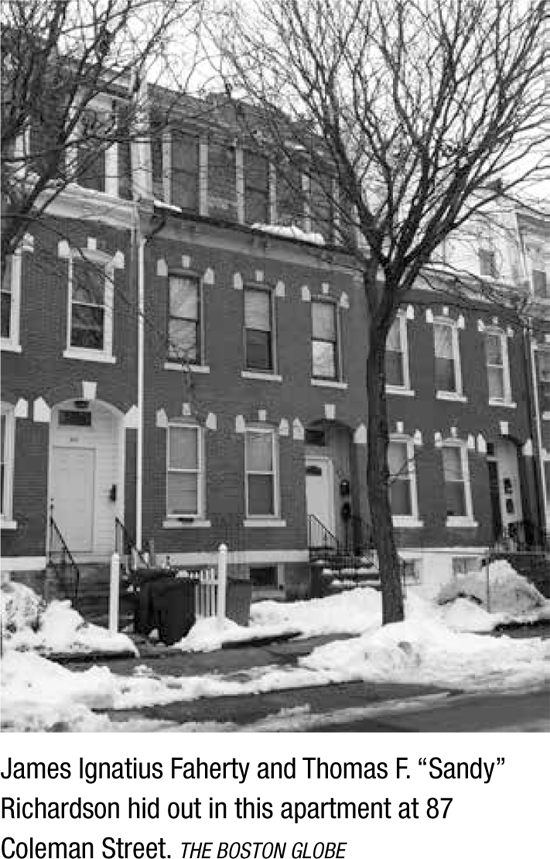
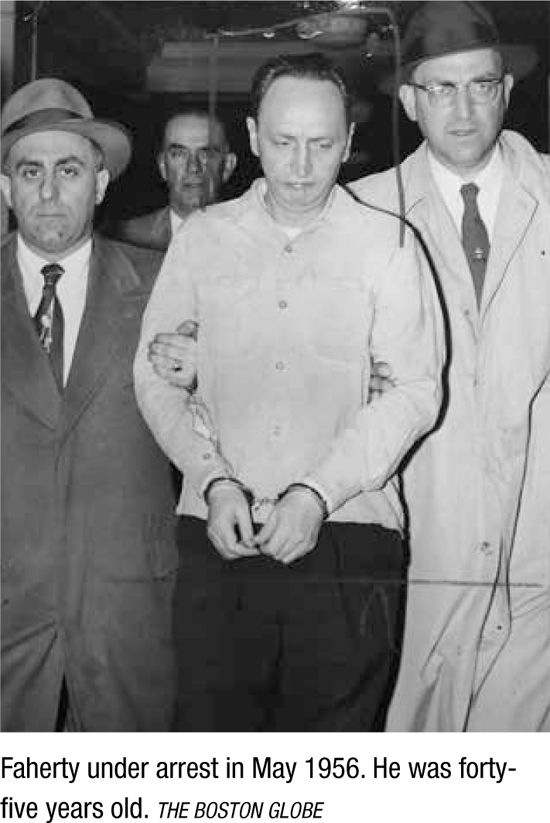
Soon after that conversation, O’Keefe decided he’d had enough. He felt his partners in crime cheated him out of his share of the loot, and they’d try to have him killed. He told two FBI agents he was willing to testify as a government witness.
Soon after O’Keefe turned on his fellow robbers, the arrests began. On January 12, 1956, Anthony Pino was arrested at his home at 26 Kennebec Street in Mattapan. Maffie, McGinnis, Costa, Baker, and Geagan were also arrested. Richardson and Faherty went into hiding and remained on the lam for four months until May 16, 1956, when, around 6:30 p.m., six plainclothes FBI agents appeared on Coleman Street in Dorchester. The agents made their way down the street separately. Some dressed as workmen, others were dressed casually and tried to appear as if they were just passing through the neighborhood. One side of the street was lined with a row of handsome brick townhouses. The agents approached the three-story townhouse at 87 Coleman Street slowly, and then walked up the steps. Once inside, they charged into the small apartment on the first floor, where they caught Faherty and Richardson by surprise. The two fugitives were just about to eat some stew for dinner. The floor of the tiny rented apartment was littered with newspapers, dog-eared magazines, and books. In less than a minute, Faherty and Richardson were handcuffed.
It wasn’t until about six month later that the police got another lead in the case. On the evening of June 3, 1956, William Smith was working at an amusement arcade at 116 East Baltimore Street in Baltimore, Maryland, when he was handed something that bothered him. A young man had just handed him a moldy, deteriorated $10 bill. Smith turned it over and looked at it more closely. Something didn’t seem right; he was worried it might be counterfeit. Smith found a police officer nearby and showed him the cruddy piece of currency.
“I think a fellow just passed a counterfeit $10 bill on me,” Smith said. The officer looked at the bill and agreed. The patrolman called his lieutenant and sergeant in to help, and together they began searching for the young man who had given Smith the suspicious money. Police quickly located the suspect—Jordan Perry, a thirty-one-year-old Boston resident with a long rap sheet. Perry told Baltimore police that that he lived at 673 Tremont Street in Boston, and that he was staying in Room 822 of the Emerson Hotel, at the northwest corner of Calvert and Baltimore Streets. He had checked into the hotel earlier that day under an assumed name. Police discovered that the brittle $10 bill he used at the arcade wasn’t the only suspicious money he was carrying—it turned out he had more than $1,000 in cash on him, mostly in $5 and $10 bills that were brown and discolored, and smelled musty.
And there was more where that came from. Police searched Perry’s hotel room and found nearly $4,000 of bills wrapped in wax paper hidden underneath the carpet. The serial numbers matched the money that had been stolen from Brinks on that fateful night in January, six years ago. It was the first time any of the Brinks loot had turned up.
At first Perry told authorities he found the old money stashed away in a cellar where he had been doing masonry work on the foundation of a house. He said he hid the money at a dump and then took it to Baltimore, where he planned to make small purchases to get newer bills. But his plan was foiled when he tried passing that $10 bill at the arcade.
When the FBI began questioning Perry, he told them he worked as a masonry contractor and shared office space on Tremont Street with a man he knew as “Fat John.” Perry said that on June 1, this man had him rip down a wall in the office, after which he witnessed “Fat John” take out a container that was hidden behind the wall. John showed Perry packages of old money, each containing $5,000.
“This is good money,” John had said. “But you can’t pass it here in Boston.”
Perry told the FBI that “Fat John” had offered him $5,000 of the moldy money if he’d agree to pass $30,000 of it. Perry said he took six packages and began traveling south the following day, passing as many bills as he could along the way.
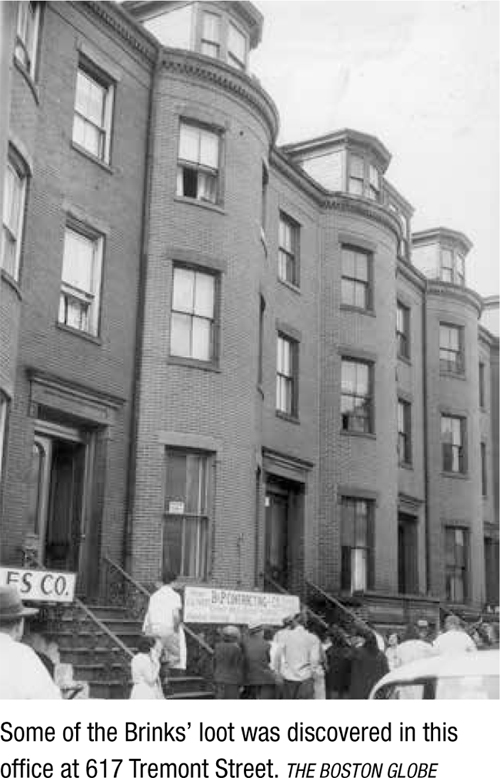
On June 4, 1956, authorities visited a business on Tremont Street operated by Wimpy Bennett, Jordan Perry, and John F. “Fats” Buccelli. It was called B&P Contracting Company, and their office occupied the basement of a four-story brick building at 617 Tremont Street.
Federal agents watched as Bennett and Buccelli walked along Tremont Street. They quietly followed them as they strolled around the neighborhood. The men, however, sensing that they were under surveillance, walked past the basement office several times and didn’t go in. Finally at 3:15 p.m. Bennett relented and went inside the office, where he was greeted by two FBI agents who placed him under arrest. Buccelli was nabbed by other agents 2 blocks away on Tremont Street. The federal agents tapped on the walls with hammers and heard a hollow sound in the southwest corner of the room. They used an ax to tear down that portion of the wall, and found a secret closet with shelves. Sitting on the second shelf was a green cooler (back then it was called a “portable refrigerator”) that was 20 inches long and more than a foot deep, and extremely heavy. It took two agents to lift it out of the secret compartment behind the fake wall. When they opened it, they found it filled with packages of cash. The bills looked old and moldy, some were so brittle that they fell apart in the hands of federal agents. The FBI concluded that the money had been buried underground at some point, and had also been soaking wet. The FBI determined that the cooler contained more than $57,700, of which $51,906 could be traced back to the Brinks robbery.

Bennett and Buccelli each served short prison terms for receiving the stolen loot.
About a month after he was released from doing time on Deer Island, Fats Buccelli was found dead in the South End on June 19, 1958.The sedan he was driving crashed into a truck that was parked at Castle Square, at the intersection of Chandler Street and Arlington Street. The forty-four-year-old had been shot twice in the back of the head.
Inside the car, police found an orchid-colored sheet covered in blood. On the floor of the backseat was a bouquet of crushed carnations, a man’s hat, a pair of pink ladies’ sunglasses with green lenses, and a bottle of medicine used to treat stomach ulcers, all of which remained a mystery. The case went unsolved.

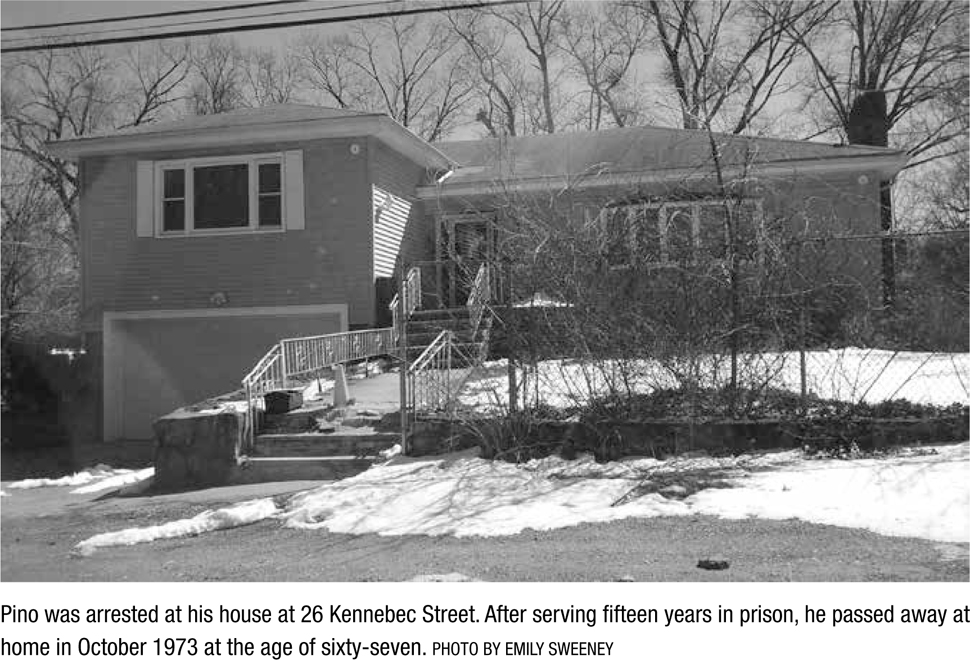
Besides the money that was recovered in Baltimore and in the Tremont Street office, the rest of the Brinks loot remained missing and would never be found. Brinks suspects James Faherty, Thomas F. Richardson, Anthony Pino, Adolph “Jazz” Maffie, Joe McGinnis, Vincent Costa, Henry Baker, and Michael Geagan were found guilty and sentenced to life in prison.
After his daring escape from prison, Elmer “Trigger” Burke tasted freedom for almost a year before being eventually captured by FBI agents at Folly Beach, South Carolina, in August 1955. Burke died in the electric chair at Sing Sing on January 9, 1958. He was thirty-nine years old, and took all of his secrets with him to the grave.
O’Keefe did four years in prison and was released in 1966. He didn’t leave his old life totally behind, however, when he began a new life on the West Coast under an assumed name as a chauffeur in Hollywood. At one point, he reportedly was the driver for Cary Grant. In a way, he’d come full circle, from that fateful night when he donned a chauffeur’s cap and participated in the crime of the century.